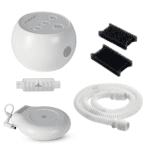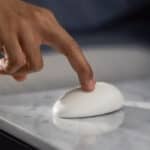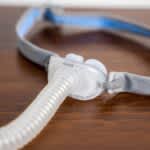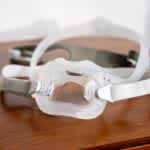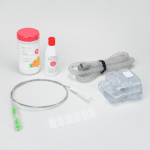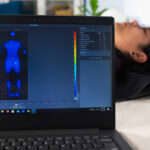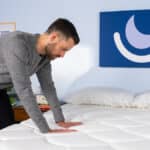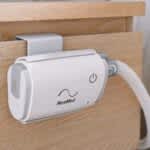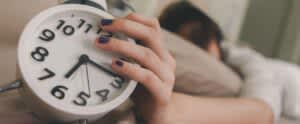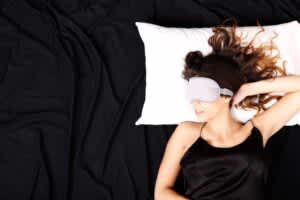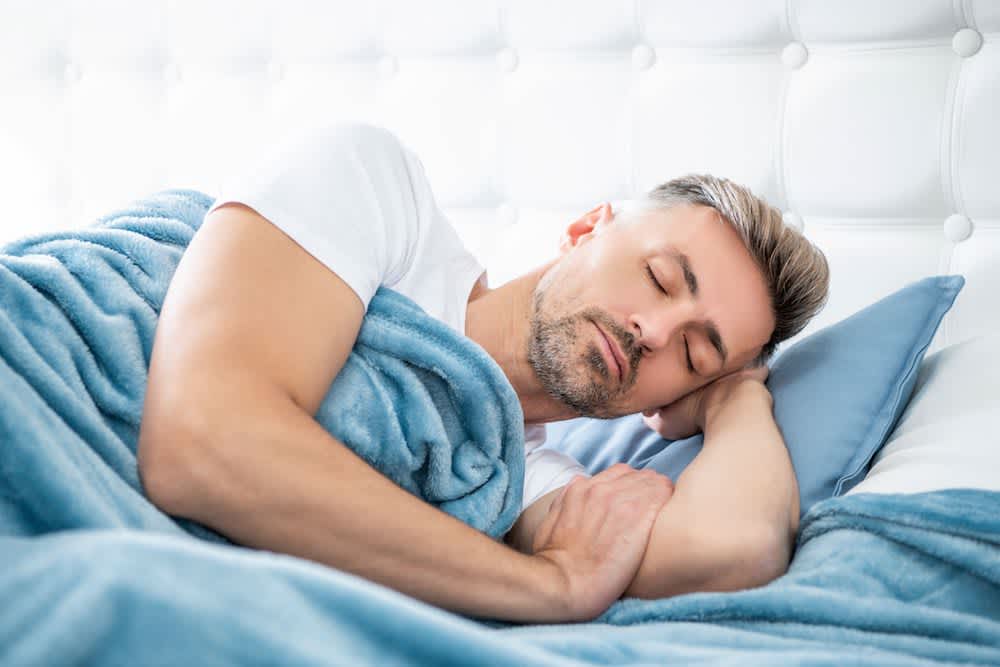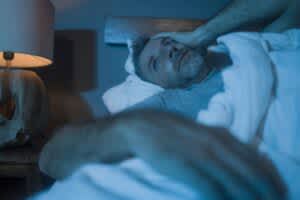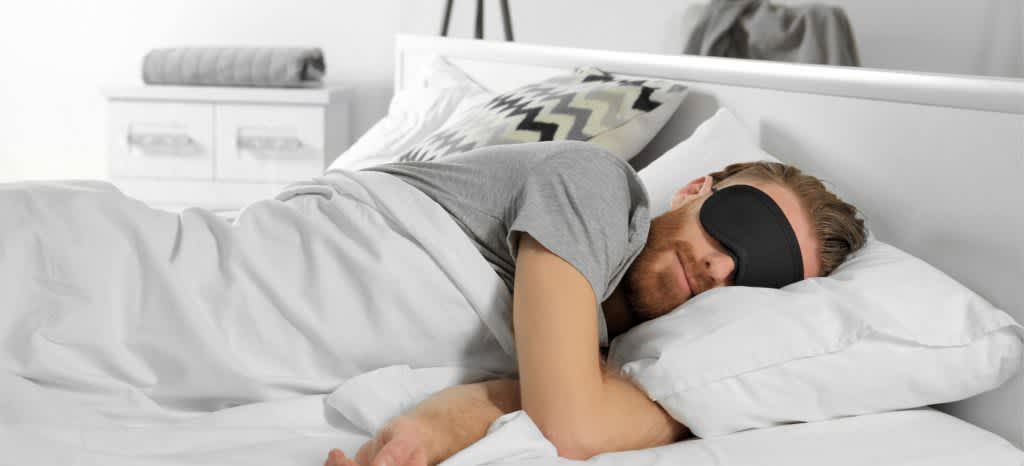Sleep latency is the medical term for the amount of time it takes a person to fall asleep once they get into bed with the lights out. A short sleep latency means that a person falls asleep within a few minutes of their head hitting the pillow. A long sleep latency means it takes longer than 20 or 30 minutes to get to sleep.
Since individuals vary quite a bit in how quickly they fall asleep, sleep latency times cover a wide range. While research has not determined what a normal range should be, unusually short or long sleep latency can be a sign of sleep problems.
We discuss sleep latency and how it is measured, how it impacts the sleep cycle, and when to talk to a doctor about sleep latency.
What Is Sleep Latency?
Sleep latency, also called sleep onset latency, is the period of time it takes someone to get to sleep once they are in bed for the night. The length of sleep latency can provide important clues about whether a person is getting sufficient sleep and whether they might have a sleep disorder.
Typical sleep latency length can be quite different among individuals. Ideally, it should take about 15 to 20 minutes to fall asleep. Experts suggest that roughly 20% of the population may fall asleep more quickly without it being a sign of any abnormal sleep tendencies.
People living with narcolepsy, non-24-hour sleep-wake rhythm disorder, and hypersomnia often have short sleep latency. By contrast, sleep latency may be longer in people with insomnia.
Age can also affect sleep latency. Children under 12 and adults over 60 typically take longer to get to sleep, while teens and young adults usually have shorter sleep latencies.
The use of certain medications may affect how long it takes a person to fall asleep. Anti-seizure medications, some anti-depressants, and certain antipsychotics may shorten sleep latency. Other drugs that have a stimulating effect can lengthen sleep latency.
Lifestyle choices also play a role in how long it takes a person to fall asleep. For example, consuming caffeine and exercising in the evening may lengthen sleep latency, while drinking alcohol can shorten it.
How Sleep Latency Impacts the Sleep Cycle
Long sleep latency affects the sleep cycle and can lead to poor sleep quality. Nighttime sleep usually consists of 4 to 6 sleep cycles lasting anywhere from 90 to 120 minutes. During each sleep cycle, people pass through a series of sleep stages broadly categorized into REM sleep and NREM sleep.
When sleep latency interferes with getting to sleep, a person may get less sleep and may cycle through fewer sleep stages. As a result, they may spend less time in REM sleep.
Abnormal sleep latency periods often occur in people who have sleep disorders linked to other sleep cycle problems. For instance, people with insomnia frequently have longer sleep latency. In some people, insomnia also causes altered sleep patterns, increasing light sleep and decreasing slow wave sleep.
People with narcolepsy tend to have short sleep latency, often under five minutes. Other changes in the sleep cycle may also occur with narcolepsy, including more nighttime awakenings, lowered sleep efficiency, and more time spent in light sleep.
Normal Sleep Latency
There is no established normal range for sleep latency because there is limited data on how long it takes healthy sleepers to fall asleep once in bed.
In diagnosing sleep problems, doctors consider other factors alongside short or long sleep latency periods. Particularly, these include whether someone has additional symptoms of a sleep disorder or a sleep history suggesting such a problem.
If it takes longer than 20 minutes for children or young adults to get to sleep, it could mean they have sleep disturbances such as insomnia or other sleep disorders. Middle-aged and older adults may have sleep problems if they have sleep onset latencies longer than 30 minutes.
A longer or shorter sleep latency period by itself does not necessarily indicate a sleep problem. This is because the amount of time it takes to fall asleep can vary greatly among healthy individuals. Additionally, sleep latency may be affected by using alcohol or cannabis, drinking caffeinated beverages late in the day, and exercising vigorously close to bedtime.
Sleep Debt and Sleep Latency
When a person does not get the amount of sleep their body requires, they accumulate sleep debt. Sleep debt is the difference between the hours of sleep a person needs and the amount of sleep they actually get.
Sleep debt can shorten sleep latency, making it more likely that a person will fall asleep quickly after they have been sleep deprived. For this reason, tests that measure sleep latency do not produce valid results if the person being tested is carrying a sleep debt.
Tests That Measure Sleep Latency
People may sometimes have their sleep latency measured as part of an evaluation for a sleep disorder. Several tests can help gather information about sleep latency.
Multiple Sleep Latency Test
The multiple sleep latency test (MSLT) measures sleepiness and how long it takes a person to fall asleep. This test is performed in a sleep laboratory in a dark, comfortable environment. The person will have sensors attached to their body that measure activity in the eyes and brain.
In a typical MSLT, a person attempts five naps. For each attempt, the person being tested tries to get comfortable and fall asleep. If the person does not fall asleep within 20 minutes, the sleep technologist ends the test and records the sleep latency as 20 minutes.
Sleep latencies from the five sessions are averaged together. The results demonstrate the average length of time it takes the individual to fall asleep.
Certain factors can affect the reliability of the test, including recreational drug use, the amount of sleep a person gets leading up to the MSLT, and the use of some prescription medications.
If your doctor recommends a multiple sleep latency test, it is important to follow any pre-test instructions closely to ensure the reliability of the results. It is also important that the results be interpreted by a board-certified sleep medicine specialist.
Maintenance of Wakefulness Test
The maintenance of wakefulness test (MWT) measures whether a person is able to stay awake for a specified period of time. This test can provide information about whether a person is responding to treatment for a sleep disorder.
The MWT is performed in a sleep lab and consists of four sessions. Unlike in an MSLT, people taking an MWT try to remain awake during each session. If they fall asleep before 40 minutes, their sleep latency is recorded. Otherwise, if they are able to stay awake for 40 minutes during all four sessions, they are considered able to maintain wakefulness.
People undergoing a maintenance of wakefulness test should follow any pre-test directions prescribed by the sleep specialist. This will help ensure the reliability of the results. As with other tests used to diagnose and monitor sleep disorders, the test results should be reviewed by a board-certified sleep specialist.
Polysomnography
Polysomnography (PSG) takes a number of measurements before and during sleep. The test is performed in a comfortable area in a sleep lab. The test taker is connected to monitoring devices that take measurements while they sleep.
Although PSG provides one measure of sleep latency, sleep specialists typically recommend PSG before a multiple sleep latency test. Sleep specialists need to ensure people have had adequate sleep prior to a MSLT performed to diagnose sleep disorders such as narcolepsy and hypersomnia.
Actigraphy
Actigraphy measures several aspects of sleep, including sleep latency, through the use of a wrist-worn device. This method is considered less reliable than testing performed in a sleep laboratory, as it depends on the test subject keeping an accurate account of when they go to bed.
Actigraphy is typically suggested in the week or two leading up to a multiple sleep latency test or a maintenance of wakefulness test. It helps sleep specialists verify that a person gets enough sleep prior to having an in-laboratory sleep study and helps eliminate sleep debt as the cause of short sleep latency.
When to Speak to a Doctor
If you regularly find that you fall asleep very quickly, or that it takes you longer than 20 minutes to half an hour to fall asleep, you may be experiencing atypical sleep onset latency. This could be due to individual variation or it could be a sign of a sleep disorder. If sleep problems persist even while you are practicing good sleep hygiene, you may wish to consult your doctor.
Speaking to a doctor is the first step in diagnosing and treating sleep problems. A doctor may thoroughly review a person’s sleep and medical history, perform a physical exam, and request that a person keep a sleep diary for a period of time. In some cases, doctors may recommend an in-laboratory sleep study.
Frequently Asked Questions
Alcohol can shorten sleep latency, making a person feel sleepy and get to sleep faster. However, alcohol can also cause more awakenings and changes in sleep quality later in the night. Using alcohol to help relax and get to sleep may actually be counterproductive, since the sleep it produces isn’t as restful.
Many things can affect the length of time it takes you to fall asleep. For example, sleep latency is often increased if you go to bed earlier than usual or have jet lag from travel. Lifestyle choices such as caffeine intake or exercising near bedtime can make it hard to fall asleep. Stress can also lengthen your sleep latency.
Other things may shorten your sleep latency, meaning you fall asleep more quickly. In addition to alcohol and sleep deprivation, cannabis use has been shown to produce short sleep latency periods.
Experts have not agreed upon a normal sleep latency. There hasn’t been enough research in people with healthy sleep habits to establish a normal range.
However, a sleep latency under eight minutes may indicate excessive sleepiness caused by a sleep disorder. Sleep latency periods of over 20 or 30 minutes, depending on a person’s age, may be a sign of insomnia.
References
Ask the Sleep Doctor
Have questions about sleep? Submit them here! We use your questions to help us decide topics for articles, videos, and newsletters. We try to answer as many questions as possible. You can also send us an email. Please note, we cannot provide specific medical advice, and always recommend you contact your doctor for any medical matters.


